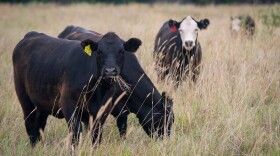As the extreme heat continues across Oklahoma, it not only poses a threat to humans, but also cattle.
According to the Oklahoma Mesonet’s cattle comfort advisor, the state has been in the "heat danger" category for the last several days.

OSU Livestock Specialist Earl Ward says the extreme heat has cattle eating much less, and producers are having to keep a sharp eye on water levels.
"We’re checking water troughs. Normally, a water trough would last you two days. They’re drinking it within a day right now," Ward said.
According to Ward, normal beef cattle consume 12-15 gallons of water a day, but with temperatures as hot as they are cattle are now drinking more like 30-40 gallons.
Pests, particularly flies, are rampant right now. Ward says the method cattle use to try to get rid of flies increases their risk for heat exhaustion.
"They try to get next to another animal to try to get the flies off of them onto another. What you see is cattle getting congregated in really tight areas sharing body heat, which makes everybody hotter."
Livestock owners are also urged to make sure there's adequate shade to help animals lower their body temperatures.
Signs of heat stress include slobbering, heavy panting, open mouth breathing and lack of coordination, according to OSU Extension. Severe cases may include depression and trembling that require some type of low stress intervention.
Extreme temperatures are also affecting other facets of the farm. Ward says the heat stress on bulls could impact fertility rates.
"If you’ve got bulls turned out on cows right now there’s a really good chance that you might see a lull in activity due to heat. If they don't have a way to cool down then we'll definitely see a reduction in pregnancy rates during this heat stress."
Ward says he and other producers are keeping their fingers crossed for cooler temperatures in the forecast.
KGOU is a community-supported news organization and relies on contributions from readers and listeners to fulfill its mission of public service to Oklahoma and beyond. Donate online, or by contacting our Membership department.
Copyright 2023 KGOU. To see more, visit KGOU. 9(MDA4OTAxNzAzMDEzMjc0MTc2MzA5ZDZlMw004))







